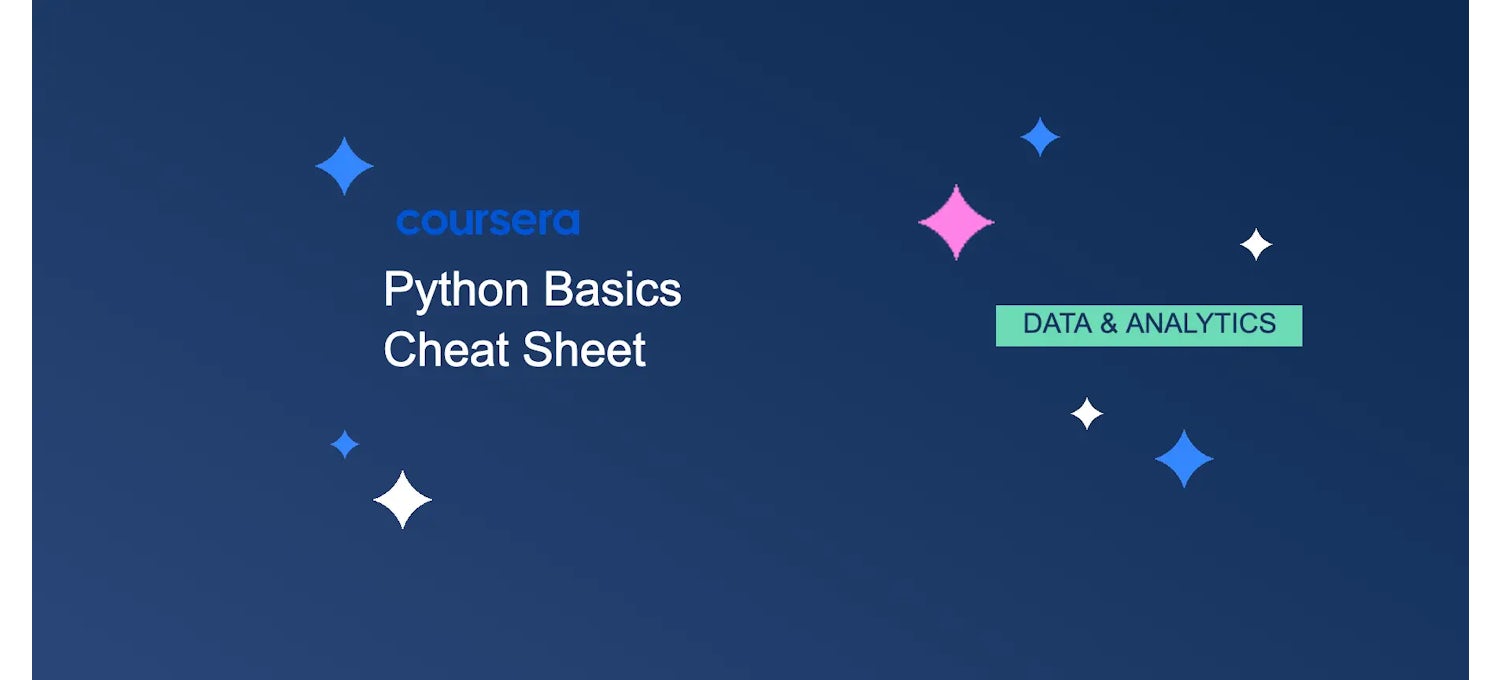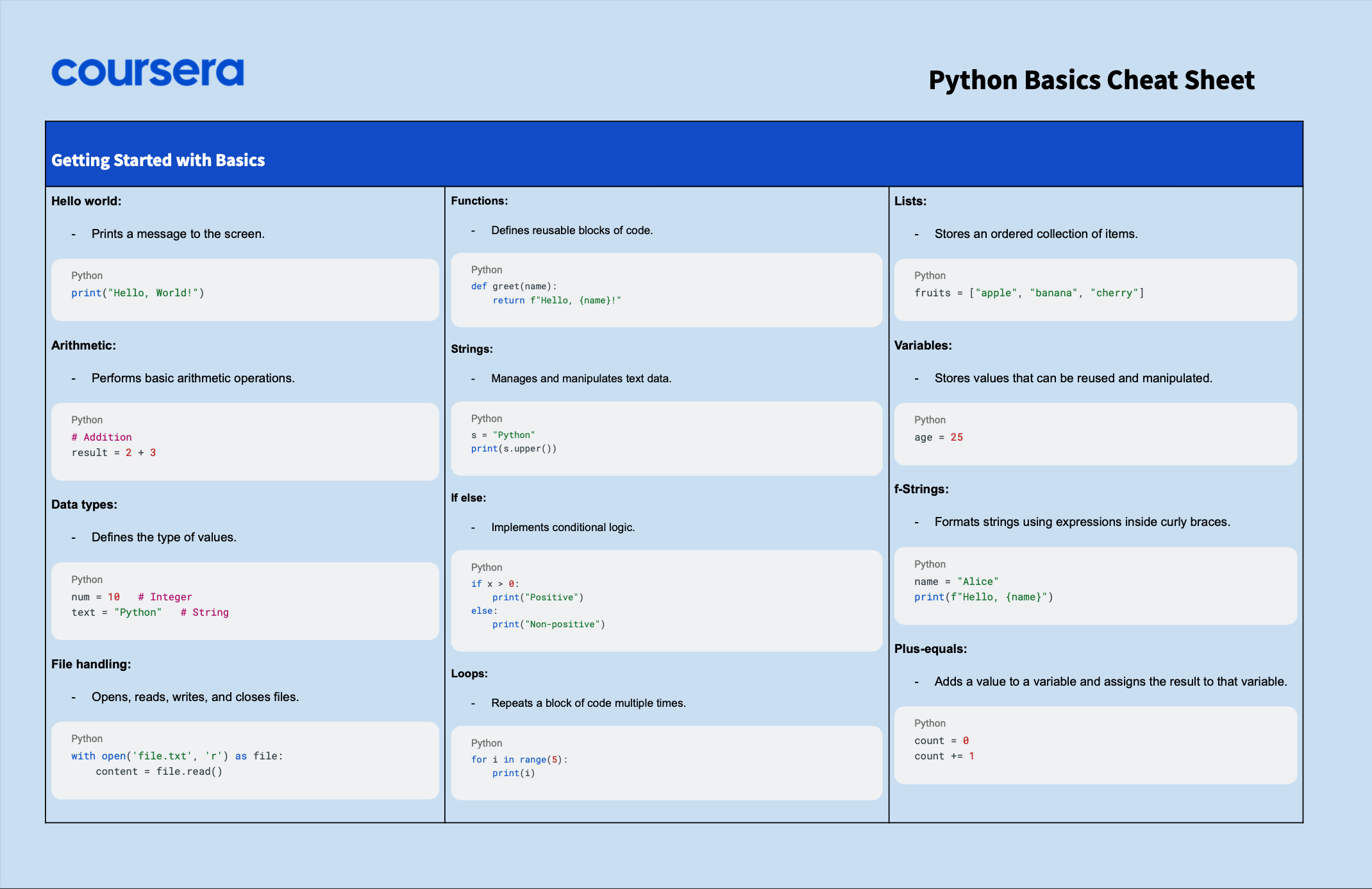Python Basics Cheat Sheet & Quick Reference
Master essential Python commands and data types. This guide covers everything from basic operations and data handling to loops, functions, modules, and classes, helping you quickly navigate common Python programming tasks.

Python is a versatile and powerful programming language that is easy to learn and widely used in various fields such as web development, data science, automation, and more. Its simplicity and readability make it an ideal choice for beginners and experienced developers. This cheat sheet provides a quick reference for the most common Python commands and types to help you get started and navigate the essentials of Python programming.

Getting Started with Basics
Hello world:
Prints a message to the screen.
print("Hello, World!")Arithmetic:
Performs basic arithmetic operations.
# Addition
result = 2 + 3Data types:
Defines the type of values.
num = 10 # Integer
text = "Python" # StringFile handling:
Opens, reads, writes, and closes files.
with open('file.txt', 'r') as file:
content = file.read()Functions:
Defines reusable blocks of code.
def greet(name):
return f"Hello, {name}!"Strings:
Manages and manipulates text data.
s = "Python"
print(s.upper())If else:
Implements conditional logic.
if x > 0:
print("Positive")
else:
print("Non-positive")Loops:
Repeats a block of code multiple times.
for i in range(5):
print(i)Lists:
Stores an ordered collection of items.
fruits = ["apple", "banana", "cherry"]Variables:
Stores values that can be reused and manipulated.
age = 25f-Strings:
Formats strings using expressions inside curly braces.
name = "Alice"
print(f"Hello, {name}")Plus-equals:
Adds a value to a variable and assigns the result to that variable.
count = 0
count += 1Python Built-in Data Types
Strings:
Text data enclosed in single or double quotes.
s = "Hello"Lists:
Ordered and mutable sequence of elements.
lst = [1, 2, 3]Dictionary:
Key-value pairs enclosed in curly braces.
d = {"one": 1, "two": 2}Booleans:
Represents True or False values.
is_active = TrueSet:
Unordered collection of unique elements.
s = {1, 2, 3}Tuple:
Ordered and immutable sequence of elements.
t = (1, 2, 3)Numbers:
Numeric data types like int, float, and complex.
num = 10 # Integer
float_num = 10.5 # FloatCasting:
Converts a variable from one type to another.
x = int(3.8) # 3Python Strings
Array-like:
Access characters using indexes.
s = "Python"
print(s[0]) # 'P'String length:
Gets the length of a string.
length = len("Python")Check string:
Checks if a substring exists within a string.
if "Py" in "Python":
print("Found!")Looping:
Iterates through characters of a string.
for char in "Python":
print(char)Concatenates:
Combines two or more strings.
full = "Hello" + " " + "World"Slicing string:
Extracts part of a string.
substr = "Python"[2:5] # 'tho'Multiple copies:
Repeats a string multiple times.
repeat = "Hi! " * 3 # 'Hi! Hi! Hi! 'Formatting:
Formats strings using {} placeholders.
s = "Hello, {}. Welcome to {}.".format(name, place)Input:
Takes user input as a string.
user_input = input("Enter something: ")Join:
Joins elements of an iterable into a single string.
join_str = ", ".join(["apple", "banana", "cherry"])Endswith:
Checks if a string ends with a specific suffix.
ends = "python.org".endswith(".org") # TruePython Lists Commands
Generate:
Creates a list with specified elements.
fruits = ["apple", "banana", "cherry"]List slicing:
Extracts parts of a list.
sublist = fruits[1:3] # ['banana', 'cherry']Omitting index:
Omits starting or ending index for slicing.
sublist_from_start = fruits[:2] # ['apple', 'banana']
sublist_to_end = fruits[1:] # ['banana', 'cherry']With a stride:
Extracts elements with step size.
stride_slicing = fruits[::2] # ['apple', 'cherry']Count:
Counts occurrences of an element in a list.
count = fruits.count("apple")Repeating:
Repeats elements in a list.
repeat_list = [0] * 5 # [0, 0, 0, 0, 0]Sort & reverse:
Sorts and reverses a list.
fruits.sort() # ['apple', 'banana', 'cherry']
fruits.reverse() # ['cherry', 'banana', 'apple']Access:
Accesses elements by index.
first_fruit = fruits[0] # 'apple'Concatenating:
Combines two or more lists.
combined = fruits + ["kiwi", "mango"]Python Loops
Basic:
Repeats a block of code for a fixed number of times.
for i in range(3):
print(i)Break:
Exits the loop prematurely.
for i in range(5):
if i == 3:
break
print(i)With zip():
Iterates over multiple iterables in parallel.
names = ["Alice", "Bob"]
scores = [85, 92]
for name, score in zip(names, scores):
print(name, score)While:
Continues until a condition is met.
count = 0
while count < 5:
print(count)
count += 1Range:
Generates a sequence of numbers.
for i in range(1, 10, 2):
print(i)Continue:
Skips the current iteration and proceeds to the next.
for i in range(5):
if i == 3:
continue
print(i)With index:
Uses range and len to loop with an index.
fruits = ["apple", "banana", "cherry"]
for i in range(len(fruits)):
print(fruits[i])for/else:
Executes else block if no break occurs.
for i in range(5):
if i == 6:
break
else:
print("Completed")Python Functions
Basic:
Defines a function with a specific task.
def greet():
print("Hello, World!")Keyword arguments:
Passes arguments by name.
def introduce(name, age):
print(f"Name: {name}, Age: {age}")
introduce(age=30, name="Alice")Anonymous functions:
Uses lambda for short, unnamed functions.
square = lambda x: x ** 2
print(square(5))Return:
Returns a value from a function.
def add(a, b):
return a + bReturning multiples:
Returns multiple values from a function.
def get_name_age():
return "Alice", 25
name, age = get_name_age()Default value:
Uses default values for parameters.
def greet(name="Guest"):
print(f"Hello, {name}!")Positional arguments:
Passes arguments in the order of parameters.
def add(a, b):
print(a + b)
add(3, 5)Python Modules
Import modules:
Imports a module to use its functions and attributes.
import math
print(math.sqrt(16))Shorten module:
Uses an alias for a module.
import numpy as npFrom a module import all:
Imports all functions and attributes from a module.
from math import *Functions and attributes:
Uses specific functions and attributes from a module.
from math import pow, pi
print(pow(2, 3))
print(pi)Python Classes
Defining:
Defines a blueprint for objects.
class Dog:
def __init__(self, name):
self.name = nameClass variables:
Variables shared among all instances.
class Dog:
species = "Canine"Polymorphism:
Uses a single interface for different types.
class Cat:
def sound(self):
return "Meow"
class Dog:
def sound(self):
return "Bark"
for pet in (Cat(), Dog()):
print(pet.sound())Overriding:
Redefines methods in a subclass.
class Animal:
def make_sound(self):
print("Generic sound")
class Dog(Animal):
def make_sound(self):
print("Bark")Inheritance:
Derives a new class from an existing class.
class Animal:
def __init__(self, name):
self.name = name
class Dog(Animal):
def __init__(self, name, breed):
super().__init__(name)
self.breed = breedUser-defined exceptions:
Creates custom exception classes.
class CustomError(Exception):
passrepr() method:
Provides a string representation of an object.
class Dog:
def __repr__(self):
return f"Dog({self.name})"Constructors:
Special methods to initialize new objects.
class Dog:
def __init__(self, name):
self.name = nameMethod:
Defines functions within a class.
class Dog:
def bark(self):
print("Woof!")This cheat sheet covers essential Python commands and concepts to help you quickly reference and master the basics of Python programming. Whether you are a beginner or looking to refresh your knowledge, Coursera offers online courses in Python to help support your career.
Further Python Resources:
Popular Python Courses:

Coursera
Writer
Coursera is the global online learning platform that offers anyone, anywhere access to online course...
This content has been made available for informational purposes only. Learners are advised to conduct additional research to ensure that courses and other credentials pursued meet their personal, professional, and financial goals.